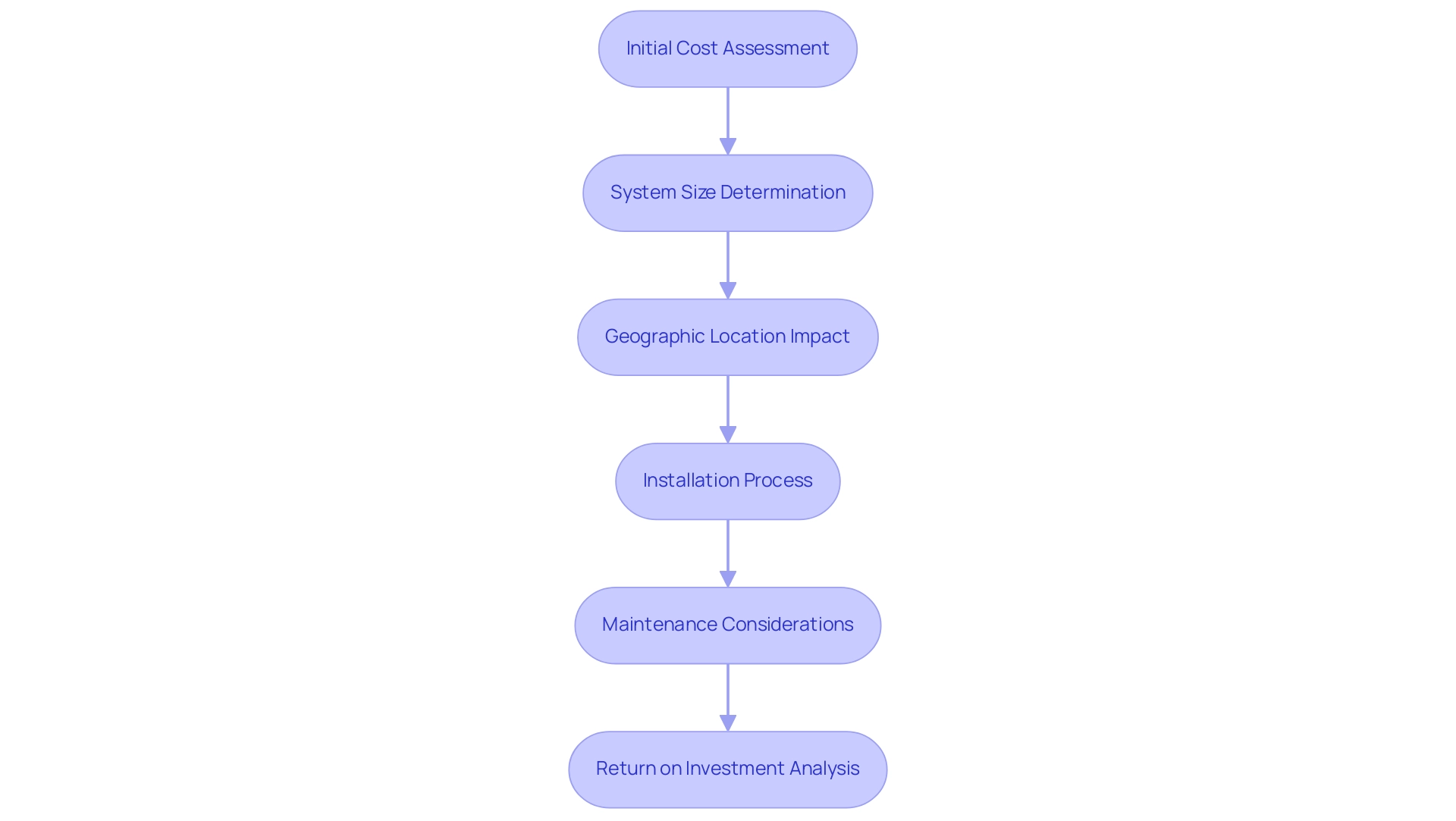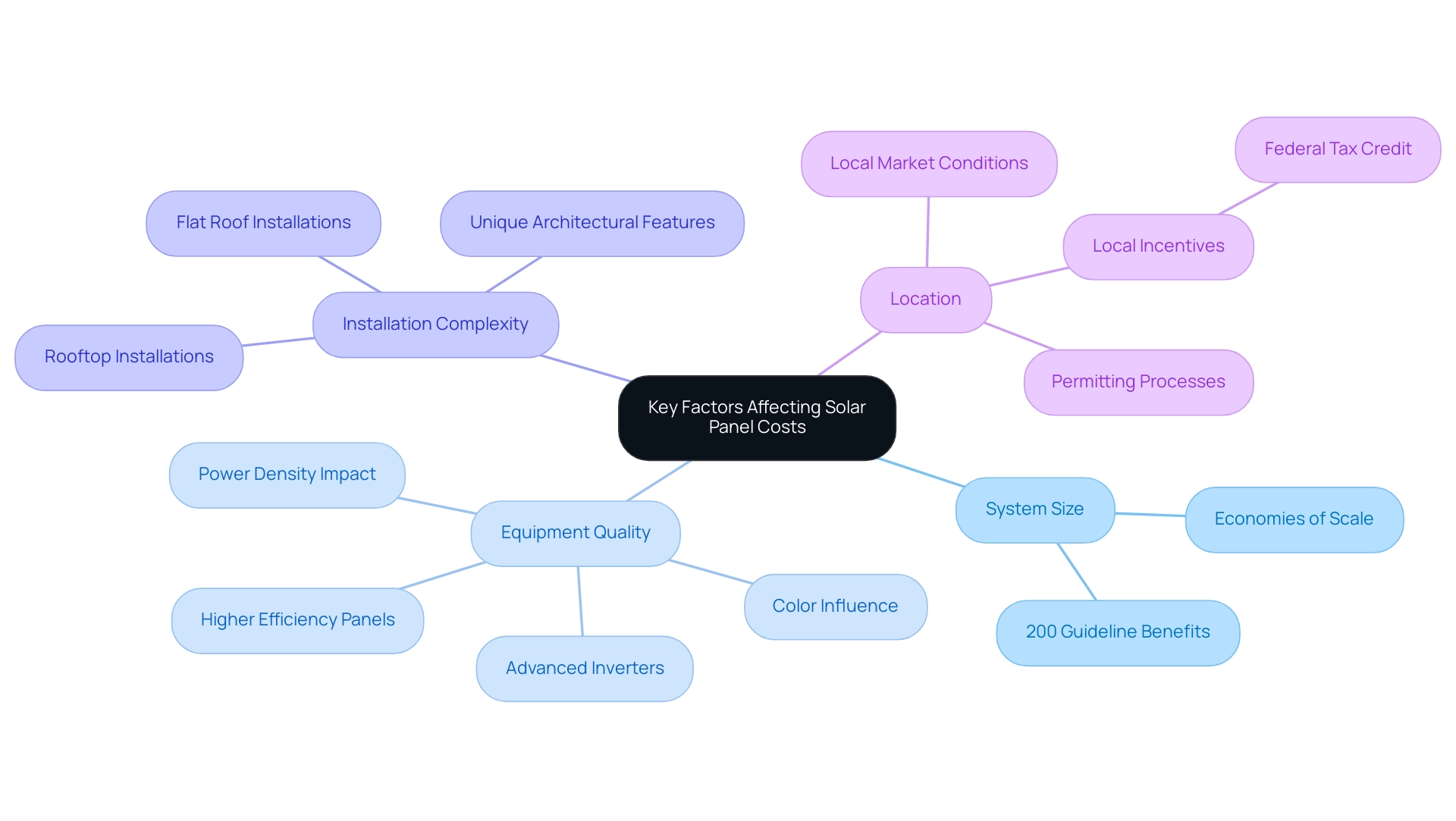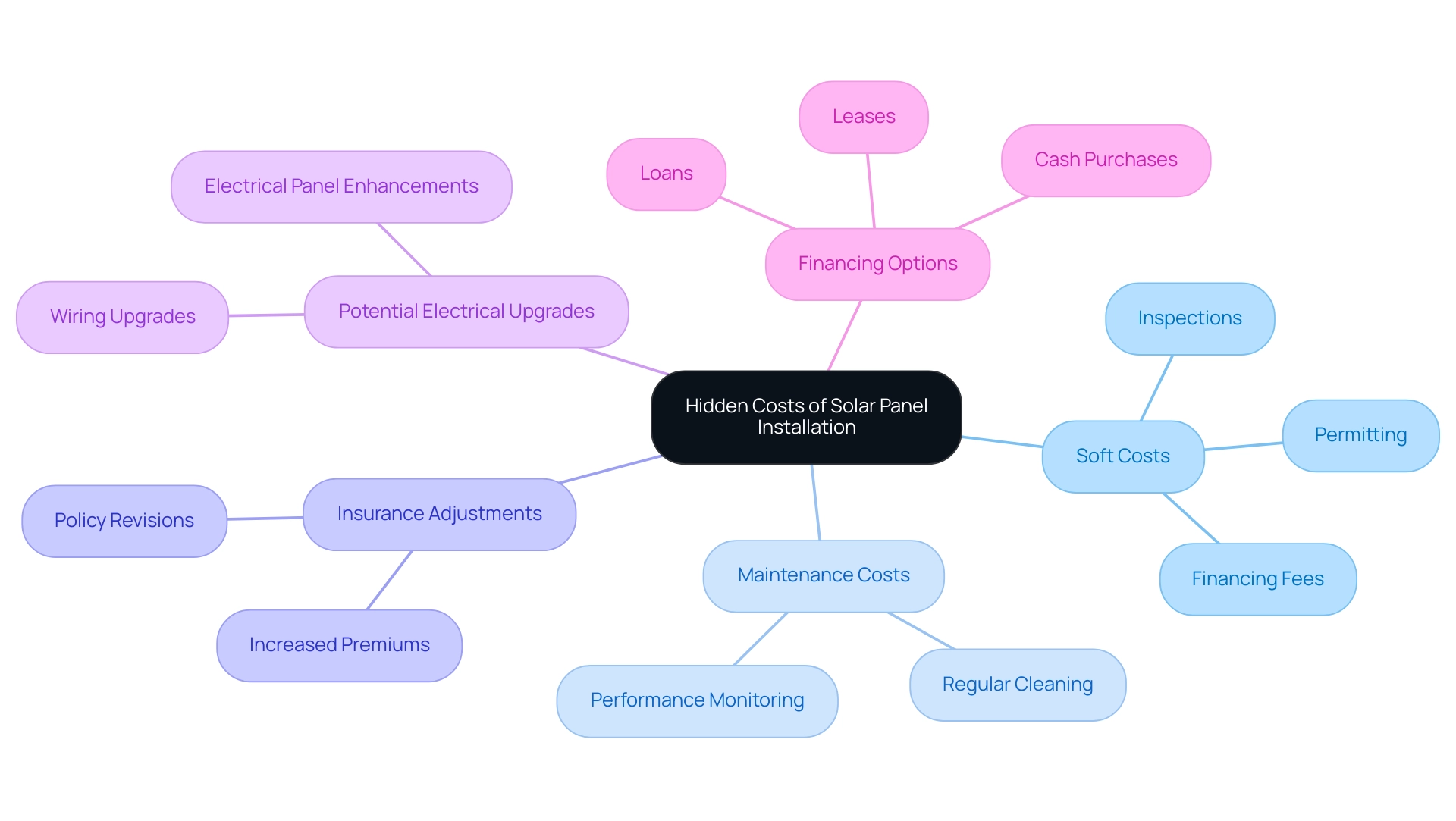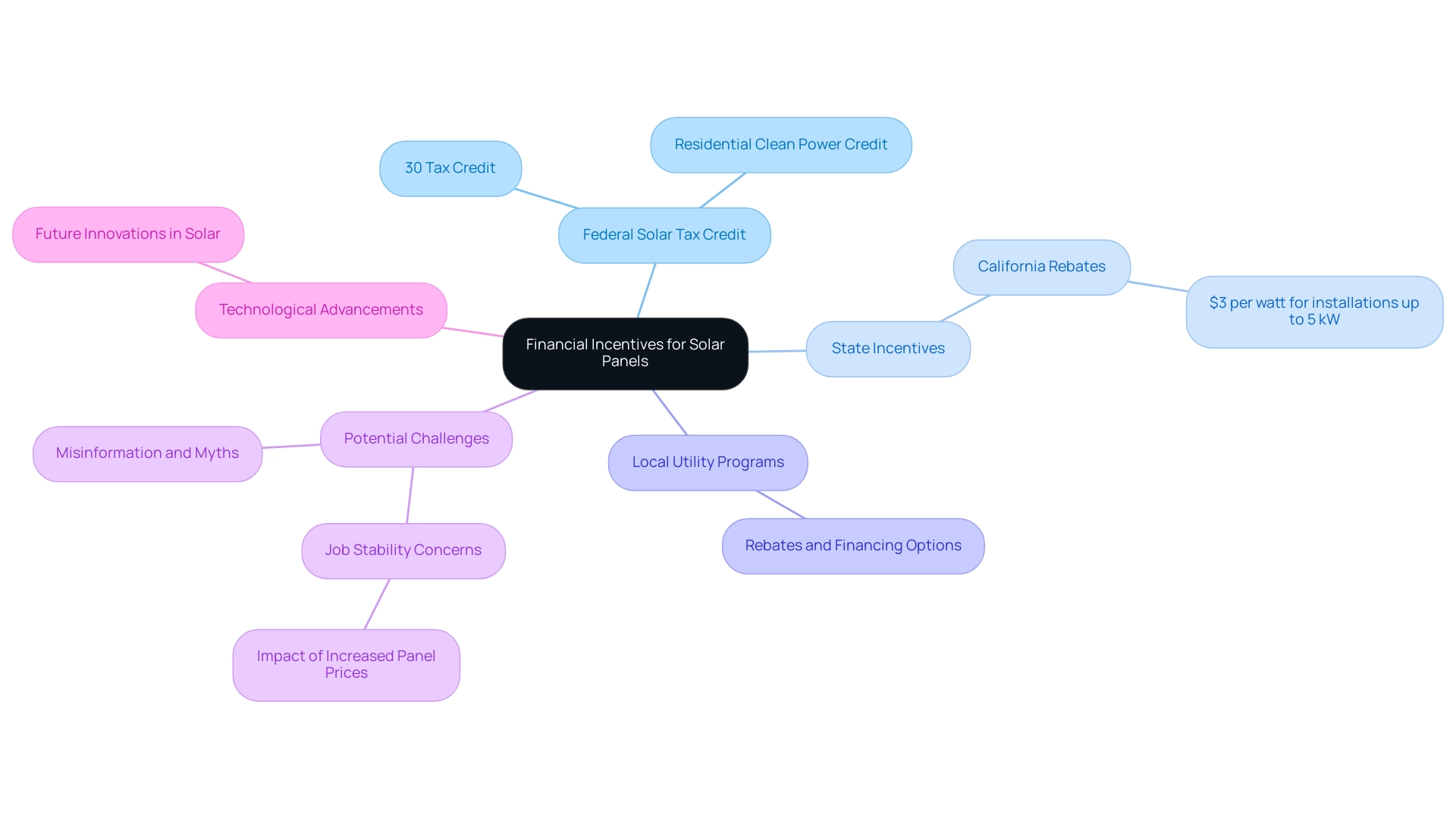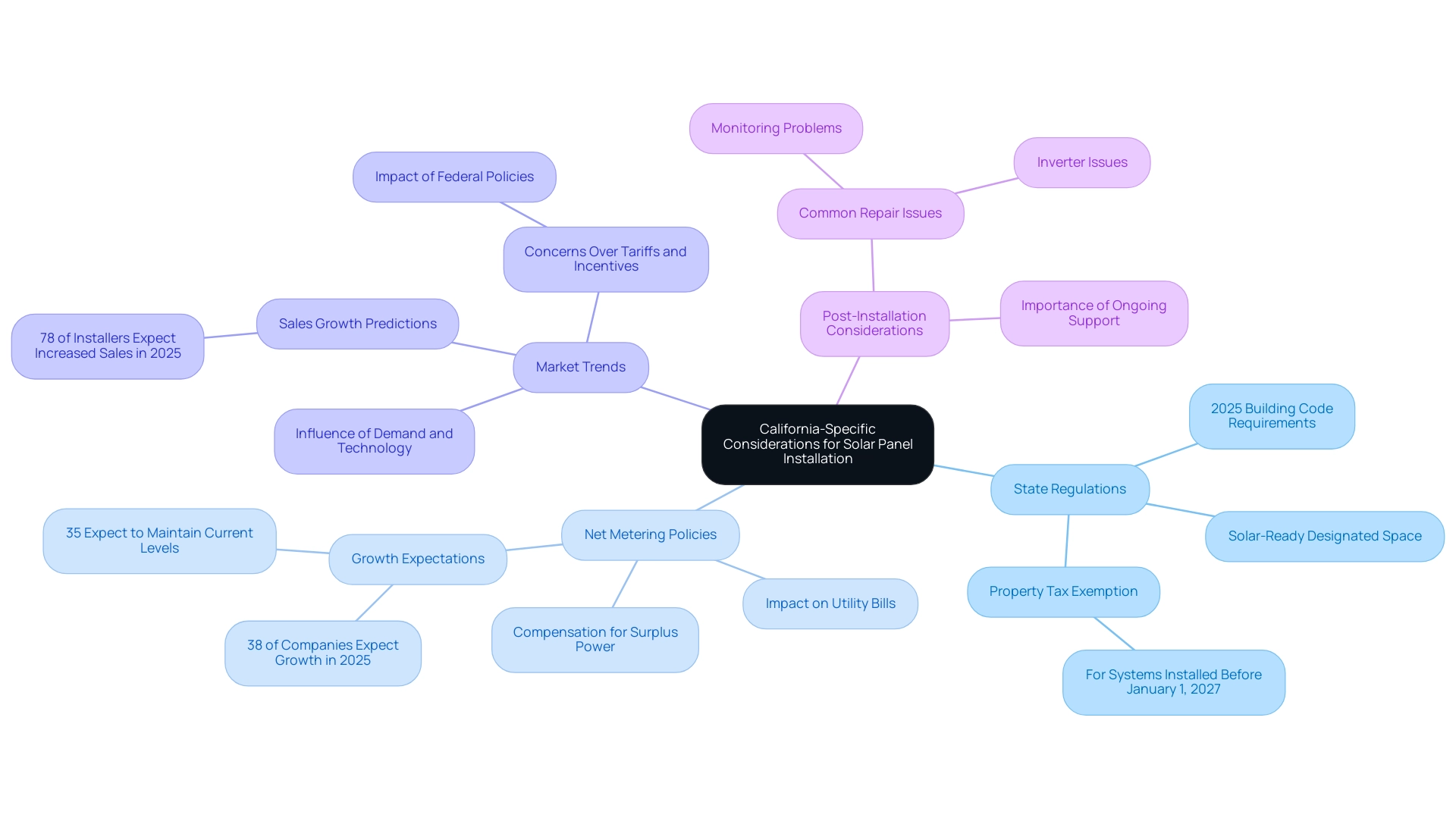Overview
We understand that the rising costs of energy bills can be a significant concern for many homeowners. The article sheds light on the costs associated with installing solar panels, outlining the various factors that influence these expenses. On average, the installation cost in the U.S. ranges from $13,549 to $25,974. However, it’s essential to consider additional aspects such as:
- System size
- Equipment quality
- Installation complexity
- Local incentives
All of which play crucial roles in determining the overall financial commitment required for transitioning to solar energy.
Imagine the peace of mind that comes with energy independence—no longer feeling at the mercy of fluctuating energy prices. By investing in solar energy, you not only contribute to a sustainable future but also take a significant step towards controlling your energy costs. Together, we can explore how these factors can work in your favor, making solar energy a viable and beneficial option for your home.
If you’re curious about how solar energy can transform your energy experience, let’s discuss how we can support you in this journey. Your concerns are valid, and we are here to help you navigate the path to a more sustainable and financially sound future.
Introduction
As the push for renewable energy intensifies, we understand that many homeowners are increasingly considering solar panel installations as a viable option for reducing both their carbon footprint and energy costs. However, it’s common to feel overwhelmed by the complexities of harnessing solar power.
From grasping the intricate cost structures to navigating financial incentives and local regulations, potential solar adopters face a myriad of factors that can significantly influence their investment. This comprehensive guide delves into the nuances of solar panel installation costs, revealing hidden expenses, exploring financial incentives, and highlighting California-specific considerations that empower homeowners to make informed decisions on their path to sustainability.
Together, we can illuminate the financial landscape of solar energy, ensuring that you can confidently embark on your solar journey with expert insights and practical advice supporting you every step of the way.
Overview of Solar Panel Installation Costs
In 2025, many homeowners are understandably concerned about the rising costs of energy. The average cost for installing solar panels in a residential system in the United States ranges from approximately $13,549 to $25,974 after applying federal tax credits. For eco-conscious property owners considering a typical 5 kW system, the expected cost is around $20,552. This figure includes both equipment and installation costs, which can vary based on factors such as geographic location, system size, and individual energy needs.
For larger residences, like a 3,000-square-foot property, the cost for a 15-kW solar panel system may reach around $39,338 after tax credits, providing valuable insights for California residents.
We understand that comprehending these expenses is crucial for property owners seeking to make informed choices about their energy investments. The financial implications of installing solar panels are significant; they not only lead to long-term savings on utility bills but also enhance energy independence and reduce environmental impact. Additionally, integrating electric vehicle (EV) charging solutions with renewable energy can amplify these benefits, allowing homeowners to power their vehicles sustainably while minimizing reliance on traditional electricity sources.
Expert insights further emphasize the importance of considering ongoing maintenance costs. Keith Lambert, a renewable energy expert, notes, ‘Photovoltaic panels, battery backup systems, etc. require routine maintenance. Solar panels need to have clean, clear paths for light. Tree limbs, leaves, sap droppings, dirt, and grime can all harm how much power you can draw from the sun.’ This highlights the importance of maintaining both the solar system and its environment to optimize savings and return on investment (ROI).
Powercore Electric’s in-house team of experts is dedicated to ensuring high-quality installations and ongoing maintenance, reinforcing our commitment to supporting homeowners in this journey.
Moreover, the payback period for photovoltaic panels typically ranges from 5 to 10 years, influenced by factors such as utility rates and financing options. Homeowners who opt for renewable energy loans can enjoy immediate savings, while those who make cash purchases may maximize their long-term savings potential. As the photovoltaic market continues to evolve, understanding these dynamics will empower homeowners to manage their energy options effectively, ensuring they reap the financial and ecological benefits of efficient heating systems and energy integration.
If you’re ready to explore how renewable energy can enhance your home and contribute to a sustainable future, reach out to Powercore Electric today for a complimentary, customized estimate. Together, we can assist you in transitioning to renewable energy and enjoying the numerous advantages it provides.
Key Factors Affecting Solar Panel Costs
As you consider the rising costs of energy bills, it’s important to understand several key factors that significantly influence the cost of solar panel installations in 2025:
- System Size: The dimensions of your solar system are crucial in determining overall expenses. Larger systems often benefit from economies of scale, resulting in a lower cost per watt. This means that as the system size grows, the cost per watt diminishes, making it more affordable for you to invest in larger installations. Understanding residential panel dimensions is vital for homeowners contemplating renewable alternatives, especially under the 200% guideline, which can enhance the advantages of your investment.
- Equipment Quality: The quality of the panels and inverters is another critical factor to consider. While higher efficiency panels and advanced inverters may require a larger upfront investment, they often lead to greater long-term savings. You should evaluate the balance between initial expenses and potential savings in efficiency throughout the lifetime of the system. Additionally, factors like power density and color can influence solar panel performance and pricing, with more power-dense panels generally being pricier. Investing in quality equipment not only enhances your energy independence but also promotes sustainability.
- Installation Complexity: The complexity of the installation can vary based on several factors, including the type of roof, its angle, and accessibility. For example, rooftop setups typically require less expenditure due to reduced labor and fewer components, whereas installations on flat roofs or those with unique architectural features may involve higher labor costs due to the additional expertise needed. Understanding these intricacies can help you anticipate possible expenses and make informed decisions regarding your energy investments.
- Location: Local market conditions and regulations also play a significant role in pricing. Installation expenses in California, particularly in Stockton, may differ from those in other states due to varying labor rates, permitting processes, and local incentives. It’s wise to research your specific area to gain insights into the costs associated with installing solar panels and available financial incentives, such as the federal tax credit for renewable energy, which can reduce installation costs by 30% or more.
Beyond these factors, the typical 25-year savings for a photovoltaic system in California is projected at $121,179, highlighting the long-term financial advantages of renewable power. Moreover, initiatives like the Biden-Harris administration’s Solar for All program aim to enhance access to renewable energy, ensuring that the benefits of photovoltaic technology are shared fairly among diverse communities. As Catherine Lane, Written Content Manager at SolarReviews, wisely states, “Grasping the financial landscape of renewable resources is essential for property owners seeking to make informed choices regarding their investments.”
By understanding these essential components, you can maximize the benefits of renewable energy solutions. Additionally, local energy firms in Stockton, such as Powercore Electric, provide tailored solutions and expertise to help you explore your energy options efficiently. Together, we can work towards a more sustainable future.
Uncovering Hidden Costs of Solar Panel Installation
While the initial cost for installing solar panels often stands out, we understand that homeowners may feel overwhelmed by several concealed expenses that can significantly influence the overall financial picture.
- Soft Costs: These encompass a variety of expenses, including permitting, inspections, and financing fees. In fact, indirect expenses can account for up to 64% of the total installation expenses in California, which boasts the lowest average price of photovoltaic installations compared to other states.
This highlights the importance of considering the cost for installing solar panels within the broader pricing structure.
- Maintenance Costs: Although photovoltaic panels are designed for longevity, typically lasting 20 to 30 years, regular maintenance is essential to ensure they operate at peak efficiency. This may involve periodic cleaning and performance monitoring, contributing to long-term expenses.
As noted in the case study on maintenance considerations, regular upkeep can prevent costly repairs and ensure that energy systems function efficiently throughout their lifespan. Innovative cleaning solutions can further enhance the performance and longevity of photovoltaic panels, making maintenance a worthwhile investment.
-
Insurance Adjustments: Homeowners may need to revise their insurance policies to adequately cover the photovoltaic system. This adjustment can lead to increased premiums, adding another layer of cost that should be factored into the overall budget.
-
Potential Electrical Upgrades: In some situations, existing electrical systems may require enhancements to support the new energy installation. This can include upgrading wiring or the electrical panel, which can further increase the total investment.
-
Financing Options: Homeowners can finance energy systems through cash purchases, loans, or leases, impacting long-term savings. Exploring these alternatives can assist in managing the financial aspects of renewable installation more effectively.
Understanding these concealed expenses, particularly the cost for installing solar panels, is vital for property owners contemplating sustainable power solutions. By being aware of the complete range of expenses, including soft costs and potential enhancements, property owners can make more informed choices and better prepare for the financial commitment involved in transitioning to renewable power. Moreover, examining the advantages of battery alternatives can improve power storage efficiency, further optimizing the investment.
As Eric Mack, a contributing editor, emphasizes, being aware of these factors can empower property owners to navigate the complexities of energy investments with greater confidence.
Additionally, it’s crucial for property owners to consult user manuals that outline how photovoltaic panels function, as this knowledge can aid in comprehending the overall system and its maintenance requirements. Homeowners should also consider government programs that may provide financial incentives or support for renewable energy installations, further enhancing the economic viability of their investment.
Exploring Financial Incentives and Rebates for Solar Panels
Homeowners often find themselves grappling with rising energy bills, and we understand that this can be a source of concern. Fortunately, in 2025, there are significant opportunities to alleviate these worries through various financial incentives available via Powercore Electric. By exploring these options, you can take meaningful steps towards energy independence and sustainability.
- Federal Solar Tax Credit: You can claim a tax credit of 30% of your installation expenses, effectively reducing your initial investment. This incentive, part of the Residential Clean Power Credit, aims to encourage the adoption of renewable sources, giving you a solid financial boost.
- State Incentives: If you reside in California, you can benefit from additional rebates, such as $3 per watt for installations up to 5 kW. These state-level incentives further reduce the overall cost of installing solar panels, making renewable energy more accessible to you.
- Local Utility Programs: Many utility providers offer rebates or financing alternatives for renewable energy systems. These programs can ease your financial burden and facilitate a smoother transition to renewable energy.
By combining federal tax credits and state rebates, substantial savings can be achieved. For instance, if you invest in a photovoltaic system priced at $20,000, the federal tax credit alone could lower your costs by $6,000, while state incentives could provide an additional $3,000, resulting in total savings of $9,000. Isn’t that an empowering thought?
However, it’s common to feel apprehensive about the renewable energy sector due to challenges like potential job losses from increased panel prices. Industry experts, like Stephen Irvin from Amicus Solar Cooperative, have noted that higher costs could hinder hiring within the sector. This highlights the importance of bipartisan support for renewable initiatives to sustain job growth and innovation. Furthermore, misinformation and misconceptions surrounding renewable sources can impede uptake, making it crucial for you to seek reliable information.
As Ifeoluwa Daniel insightfully mentioned, “Technological advancements are poised to revolutionize residential photovoltaic systems in 2025.” Grasping these financial benefits is essential for anyone seeking to invest in sustainable power solutions. Additionally, examining alternatives like Tesla home chargers and panel functionality can further enhance efficiency and sustainability in your home.
At Powercore Electric, we are dedicated to offering competitive rates and outstanding service, ensuring that together we can optimize your investment in renewable energy. Let’s work towards a more sustainable future, where your energy independence is within reach.
California-Specific Considerations for Solar Panel Installation
California homeowners, we understand that evaluating panel installation can feel overwhelming, especially when considering the impact on your energy bills. It’s essential to be aware of several critical factors that can guide your decision-making process.
- State Regulations: Starting in 2025, California’s building code will require newly constructed low-rise residential buildings to be ready for renewable energy installations, including designated space for these systems. This regulation not only encourages the adoption of renewable resources but also aligns with our shared commitment to sustainability, a principle that Powercore Electric embodies through personalized solutions across both Northern and Southern California.
- Net Metering Policies: Understanding net metering is crucial for homeowners, as these regulations determine how you are compensated for any surplus power generated by your photovoltaic systems. In California, net metering allows you to earn credits on your utility bills for excess energy, effectively reducing your overall energy costs. Recent insights reveal that 38% of energy companies expect growth in 2025, reflecting optimism about the benefits of net metering, while 35% anticipate maintaining their current business levels.
We encourage you to explore local programs that might offer rebates or financing options, significantly impacting the overall cost of installing solar panels. For instance, California provides property tax exemptions for photovoltaic systems installed before January 1, 2027, motivating residents to invest in renewable energy technology. At Powercore Electric, we are dedicated to helping homeowners navigate these incentives and understand the costs associated with solar panel installation, ensuring you maximize your investment in clean energy solutions.
- Market Trends: The photovoltaic market in California is continually evolving, with prices influenced by demand, technological advancements, and regulatory changes. A recent survey indicated that 78% of renewable energy installers expect an increase in sales in 2025, showcasing a robust market poised for growth. However, potential disruptions from new tariffs and changes to incentives remain a concern, as highlighted by case studies on the impact of federal policies on the energy sector.
While these uncertainties may present risks, companies like Powercore Electric remain optimistic about supportive measures that will foster the growth and installation of renewable technologies.
- Post-Installation Considerations: After installation, it’s common to face challenges. Monitoring and inverter issues are among the most frequent repairs reported by installers, which could affect the long-term performance of your systems.
At Powercore Electric, we emphasize the importance of ongoing support and maintenance to ensure your installation performs optimally. By staying informed about these factors, you can make educated decisions regarding panel installations, ensuring you maximize your investment in clean energy solutions while benefiting from our expertise in tailored installations. Together, let’s work towards a sustainable future. For more information on how Powercore Electric can assist you with your solar needs, please reach out to us today.
Conclusion
As you consider the journey toward solar energy adoption, it’s essential to recognize the opportunities and challenges that lie ahead. Many homeowners share concerns about energy bills, and understanding the average installation costs—ranging from $13,549 to $25,974 after federal tax credits—is a crucial first step in making informed decisions. Factors such as system size, equipment quality, installation complexity, and local regulations significantly influence your overall investment. Additionally, being aware of hidden costs, including soft costs and maintenance needs, will help you prepare for the financial commitment involved in transitioning to solar power.
Financial incentives are here to support you in making solar energy more accessible. With the federal solar tax credit and various state and local rebates available, you can realize substantial savings, significantly reducing your initial investment. Homeowners in California, in particular, benefit from specific regulations and incentives that promote solar adoption, reflecting the state’s dedication to sustainability.
As the solar market continues to evolve, it’s common to feel overwhelmed by the myriad of options available. Staying informed about market trends and post-installation considerations is essential for potential adopters like you. By leveraging expert insights and understanding the full scope of costs and incentives, you can confidently embark on your solar journey. This decision not only contributes to your personal energy independence but also plays a vital role in fostering a sustainable future for our community and the planet. Embracing solar energy is a powerful step toward reducing carbon footprints and enhancing long-term savings, making it an investment worth considering for any eco-conscious homeowner. Together, we can work towards a brighter, more sustainable future.



